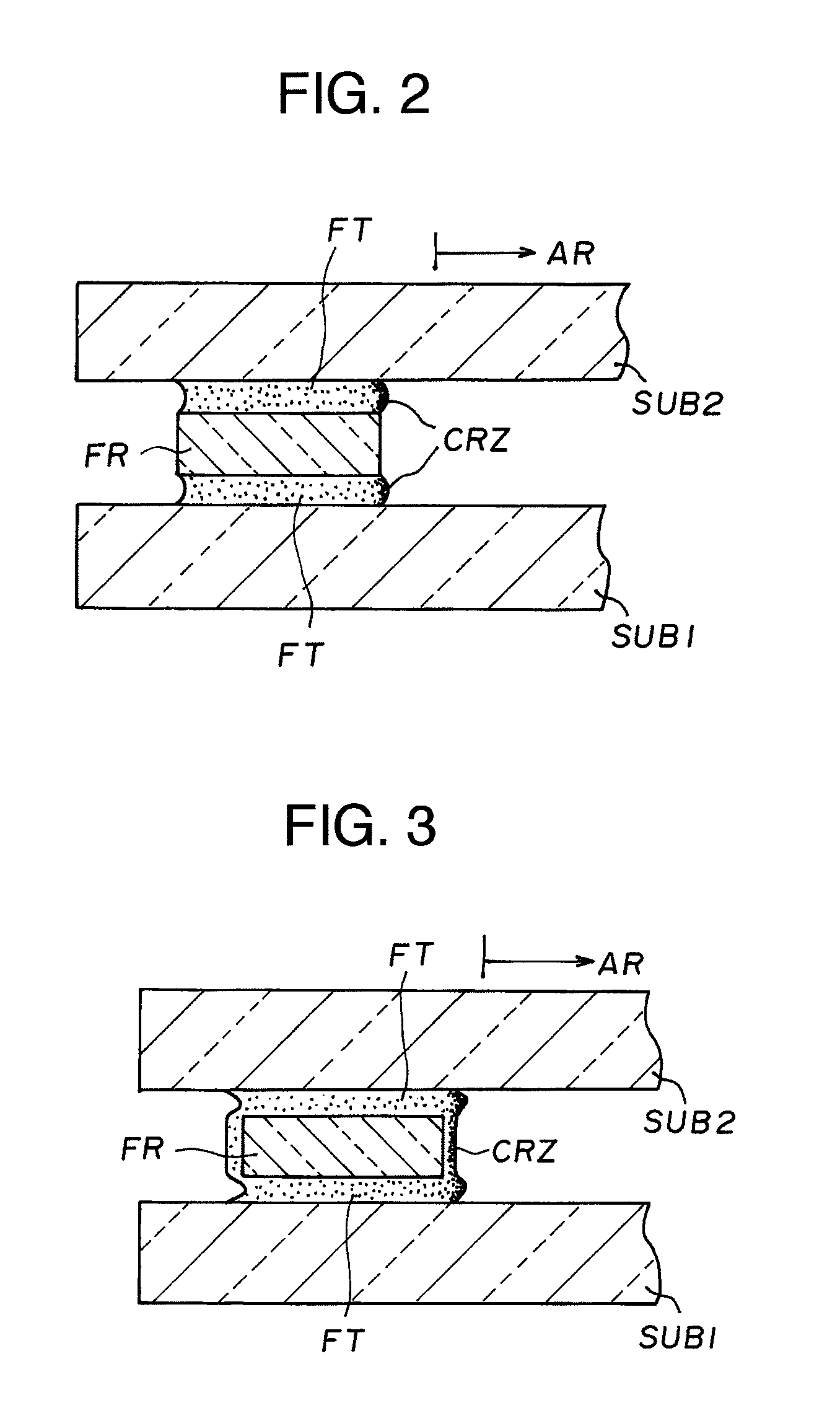Display device and production method thereof
a technology of a display device and a production method, which is applied in the manufacture of electrode systems, electric discharge tubes/lamps, transportation and packaging, etc., can solve the problems of reducing the degree of vacuum, affecting the effect of vacuum, and requiring adhesive strength, so as to achieve easy crystallization, easy crystallization, and convenient us
- Summary
- Abstract
- Description
- Claims
- Application Information
AI Technical Summary
Benefits of technology
Problems solved by technology
Method used
Image
Examples
example 1
[0037]FIG. 2 is a cross sectional view of a principal part explaining Example 1 of a display device according to the present invention. In FIG. 2, the adhesive layer FT is applied to between the respective contact surfaces of the first glass substrate SUB1 and sealing frame FR, as well as of the second glass substrate SUB2 and sealing frame FR. In Example 1, a crystalline layer CRZ is provided in the surface of the adhesive layer FT facing to the interior on a display region AR side. The layer thickness of this crystalline layer CRZ is approximately 10 μm.
[0038]The assembly is carried out so that the first glass substrate SUB1, the second glass substrate SUB2, and the sealing frame FR may provide an airtight container. In this airtight container, the sealing frame FR to which the adhesive layer FT is applied is interposed between the first glass substrate SUB1 and the second glass substrate SUB2, and the interior on the display region AR side is vacuum pumped while heating. Nonlead ...
example 2
[0042]FIG. 3 is a cross sectional view of a principal part explaining Example 2 of a display device according to the present invention. In FIG. 3, the adhesive layer FT is applied to the whole surface including between the respective contact surfaces of the first glass substrate SUB1 and the sealing frame FR, as well as of the second glass substrate SUB2 and the sealing frame FR, and the side surfaces. In Example 2, the crystalline layer CRZ is provided in the surface of the adhesive layer FT facing to the interior on the display region AR side. Other structures are the same as those of Example 1. Then, the processes of heating, reheating, and vacuum pumping the airtight container are the same as those of Example 1.
[0043]Then, also in Example 2, in the first heating, the crystalline layer may be formed also in the outer surface of the adhesive layer FT by making the atmosphere of the whole interior of the baking furnace reductive. Accordingly, a decrease in adhesive strength due to ...
example 3
[0044]FIG. 4 is a cross sectional view of a principal part explaining Example 3 of a display device according to the present invention. In Example 3, the crystalline layer CRZ is formed in the surface of the adhesive layer FT of the sealing frame FR except each contact surface of the first glass substrate SUB1 and the sealing frame FR, as well as of the second glass substrate SUB2 and the sealing frame FR. This example is a structure suitable for display devices designed to seal a gas inside the airtight container, e.g., a plasma display device.
[0045]That is, Example 3 is suitable for sealing in the case where the interior of the airtight container is not in a highly low-pressure atmosphere like the vacuum state of Example 1 or Example 2. For this reason, although it is not necessary to interpose the adhesive layer FT between the respective contact surfaces of the first glass substrate SUB1 and sealing frame FR, as well as of the second glass substrate SUB2 and sealing frame FR, in ...
PUM
| Property | Measurement | Unit |
|---|---|---|
| thickness | aaaaa | aaaaa |
| thickness | aaaaa | aaaaa |
| grain diameter | aaaaa | aaaaa |
Abstract
Description
Claims
Application Information
 Login to View More
Login to View More - R&D
- Intellectual Property
- Life Sciences
- Materials
- Tech Scout
- Unparalleled Data Quality
- Higher Quality Content
- 60% Fewer Hallucinations
Browse by: Latest US Patents, China's latest patents, Technical Efficacy Thesaurus, Application Domain, Technology Topic, Popular Technical Reports.
© 2025 PatSnap. All rights reserved.Legal|Privacy policy|Modern Slavery Act Transparency Statement|Sitemap|About US| Contact US: help@patsnap.com



